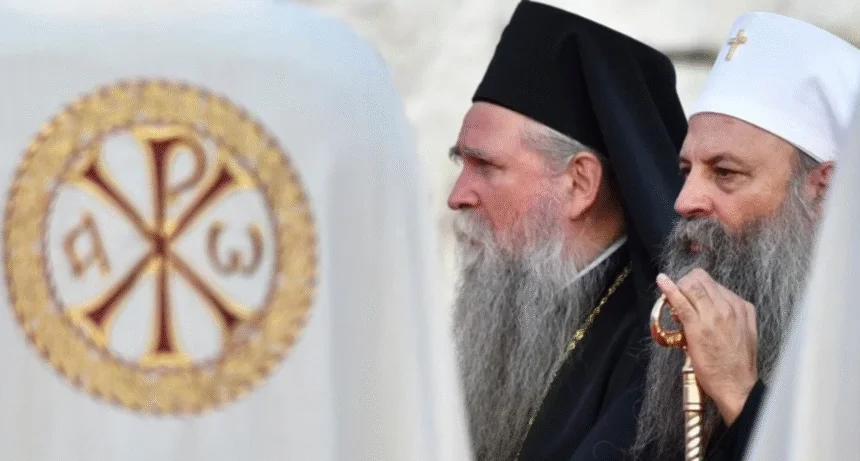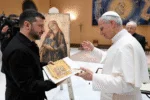From praise to decoration and even sainthood.
There are numerous examples of such an approach by the Serbian Orthodox Church (SOC) and its representatives toward convicted war criminals from both recent and distant history.
“The Church views history through an ethnophyletist [nationalist] lens, where the Serbian side is portrayed as a perpetual victim,” says historian Vladimir Velković.
In this context, he adds, the revisionism of the 1990s wars and even World War II can be understood.
“Since the wars of the 1990s are interpreted as ‘inevitable conflicts’ between different ethnic groups, history also turns to movements, figures, and conflicts that preceded them. In both cases, the role and responsibility of church figures is avoided,” Velković emphasizes.
The Serbian Orthodox Church did not respond to Radio Free Europe’s inquiries about its stance on war criminals from World War II and the 1990s wars in the former Yugoslavia.
The Church’s Stance Toward Collaborators with Occupiers
A statement by the Metropolitan of Montenegro, Joanikije, who described Chetnik commander Pavle Đurišić as “a great hero with an unbreakable character,” is just one of many that have sparked public outcry.
Đurišić’s forces were responsible for massacres of Muslim civilians in northern Montenegro, Sandžak, and eastern Bosnia during World War II. He was awarded the Iron Cross by Hitler for his “military virtues.”
“This reflects what sociologist Todor Kuljić called ‘anti-antifascism’ where fascism is not problematic due to ideology, but only when Serbs are the victims,” says Branimir Đurović of the Youth Initiative for Human Rights.
Historian Velković also mentions cases of bishops being canonized despite collaborating with occupying regimes during WWII. One example is Irinej Ćirić, canonized in 2022 with the blessing of Patriarch Porfirije.
The Church claims he saved 3,000 pregnant women, children, and mothers with infants from the Hungarian internment camp in Šarvar, sheltering them in 55 parishes across Vojvodina. However, Velković notes this conceals the fact that Ćirić was a collaborator with Hungary’s Horthy regime, having been appointed in 1943 as a member of the Hungarian Upper House of Parliament a position he held even after the war.
Velković emphasizes even more extreme cases in Montenegro. One such case is Milorad Vukojičić, a member of the Chetnik movement, convicted and executed for war crimes in Montenegro. He was canonized in 2005.
That same year, Father Slobodan Šiljak, executed in 1943 for serious crimes against civilians in Pljevlja, was also canonized. Despite protests from victims’ families, the Church denied that they were war criminals.
“Glorification of crimes from both World War II and the 1990s is part of an ideology that has never been interrupted,” Đurović states.
The Church’s Role in the 1990s Wars
Historian Velković notes that the Church played a key ideological role in preparing for the wars beginning in the late 1980s. During the conflicts, it engaged in nationalist propaganda, with clergy publicly supporting the military aims of Slobodan Milošević’s regime.
One of the most widely discussed examples is a video of a priest blessing the “Scorpions” paramilitary unit before their execution of six Bosniak civilians from Srebrenica in Trnovo, in July 1995.
“Some bishops fully identified with the Serbian side, justifying it regardless of its actions. There’s a video of Bishop Vasilije Kačavenda in Srebrenica in July 1995,” recalls Velković.
Kačavenda had close ties to Radovan Karadžić and Ratko Mladić both convicted of genocide and war crimes in The Hague. In video footage from Mladić’s trial, commander Milenko Živanović is seen briefing Kačavenda on the “Srebrenica operation,” with the bishop smiling as he hears that the mosque’s minaret has been “flattened.”
Kačavenda praised the “brave general and Serbian Obilićs,” adding, “The day is coming when the Serbian state will be rebuilt after the Battle of Kosovo.”
His position in the Church was never questioned. He resigned in 2013 citing health issues, precisely as pedophilia allegations emerged.
Similar allegations surrounded another bishop, Filaret, who in the 1990s posed with an automatic rifle and a skull he claimed belonged to a Serbian child killed by Croatian soldiers. He was removed in 2015, but the Church never stated a reason.
Decorations for Convicted War Criminals
Before his removal, Filaret awarded Vojislav Šešelj convicted by The Hague Tribunal and sentenced to 10 years in prison for inciting persecution and the expulsion of Croats from Hrtkovci in 1992 the “White Angel of the First Order” decoration.
“God gave you the strength to cleanse the stain from the Serbian people. We followed you and applaud your brave and heroic struggle,” Filaret told him at the 2015 ceremony.
Šešelj, the ideologue of the “Greater Serbia” project and organizer of paramilitary units, received another decoration from Metropolitan Amfilohije of Montenegro.
“We live in a time of great injustices against the Serbian people. You, Mr. Šešelj, are one of the defenders of divine justice,” Amfilohije said at the award ceremony.
Amfilohije, who died in 2020, was known for openly supporting Serbian forces in Croatia and Bosnia during the wars. In January 1992, he opened the gates of the Cetinje Monastery to the infamous commander Željko Ražnatović – Arkan and his armed unit.
In 2022, Šešelj received a third decoration from Bishop Irinej, representative of the Diocese of New Gracanica and Central and Western America.
That same year, General Vladimir Lazarević convicted in The Hague for crimes against humanity against Kosovo Albanians was also honored. He received the award for “cultivating love for people and Orthodox values” from Bishop Pahomije who was accused of pedophilia and in 2024 was promoted to Metropolitan.
The Church in Line with the State
“Today, denial and revisionist practices persist, led by state institutions but rooted in the Church’s role in the 1990s wars,” says Đurović.
Both the state and the Church continue to deny the genocide of more than 8,000 Bosniaks in Srebrenica and other crimes committed by Serbian forces.
Before departing for the 2024 UN General Assembly, the President of Serbia received Patriarch Porfirije’s “blessing” to oppose the Srebrenica Resolution.
Even after the war in Kosovo, the Church supported the state’s policy of non-recognition of Kosovo’s independence. Former Patriarch Irinej stated that “Serbian heritage must be defended, with goodwill or by force.” In 2024, Patriarch Porfirije declared that “The Serbian Orthodox Church cannot participate in negotiations or political agreements concerning Kosovo.”
The Church’s status is part of the 2023 EU-mediated Agreement on the Normalization of Relations between Kosovo and Serbia.
That same year, the Church faced accusations of storing smuggled weapons in its facilities in Kosovo — allegations it denied.
After the September 2023 armed attack against the Kosovo Police, a group of armed Serbs led by Milan Radoičić took refuge in the Banjska Monastery.
The Diocese of Raška–Prizren issued a statement expressing concern over “the entry of an armed and masked group in an armored vehicle that broke the locked gate of the monastery.”
The Church refused Kosovo institutions’ offer to fund repairs for the damages to the monastery.







